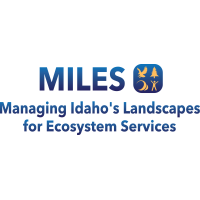Fish specimen records from 1957 to 2011 for the Portneuf Drainage Basin were compiled and georeferenced to create dot-distribution maps for each fish species. The fish occurrence records were obtained from the Idaho Museum of Natural History specimens collected by various researchers and ichthyology classes from 1957 to 1981. The fish riverine surveys were collected by the Region 5 office of Idaho Department of Fish and Game [1991 to 2011] by electrofishing method (see details below). These fish riverine records were organized in tables in 2014 using descriptions by collectors and georeferenced using GEOLocate an online web service.
This dataset is part of the larger Managing Idaho’s Landscapes for Ecosystem Services (MILES) study, an NSF/EPSCoR funded project to understand the impact of climate change and urban growth on social and ecological systems and services in mid-sized cities in Idaho. This information will be used to develop distribution models for each species to gain a more complete picture of where fish are distributed within the Portneuf Drainage** and what environmental factors are influencing where fish occur.
The Portneuf Drainage is 3,434 square kilometers located in the Northern Basin and Range Ecoregion in Southeastern Idaho. The climate for the region is characterized as temperate and continental, with primary land cover types shrub-scrub, cultivated crops, evergreen forest, herbaceous vegetation, and deciduous forest. The elevation ranges from 1,309 to 2,821 meters and includes the Bannock and Portneuf mountain ranges. There are 927 kilometers of perennial streams, 1,453 kilometers of intermittent streams, and 225 kilometers of excavated canals. The Portneuf River (156 kilometers in length) is the main channel within the basin and has been highly modified by a dam to form Chesterfield Reservoir, channelization, diversions for irrigation, and flood control structures.
Electrofishing is a common scientific survey method used to sample fish populations to determine abundance, density, and species composition. When performed correctly, electrofishing results in no permanent harm to fish, which return to their natural state in as little as two minutes after being stunned.
Data and Resources
- Geodatabase containing both museum specimens and riverine surveyszip
These fish riverine records were organized in tables in 2014 using...
Download
| Field | Value |
|---|---|
| Modified | 2019-03-19 |
| Release Date | 2018-09-12 |
| Publisher | |
| Identifier | 2c4c4440-2a51-4cc4-bbc9-eaf92313f902 |
| Spatial / Geographical Coverage Area | POLYGON ((-112.63732910156 42.256983603767, -112.63732910156 43.004647127794, -111.92321777344 43.004647127794, -111.92321777344 42.256983603767)) |
| Spatial / Geographical Coverage Location | Pocatello, Idaho, USA |
| Temporal Coverage | Tuesday, January 1, 1957 - 00:00 to Saturday, January 1, 2011 - 00:00 |
| Language | English (United States) |
| License | cc-nc |
| Author | |
| Contact Name | Dr. Charles Peterson |
| Contact Email | |
| Public Access Level | Public |
| DOI | 10.7923/G4F769GR |

